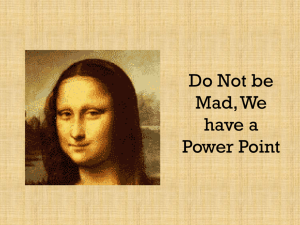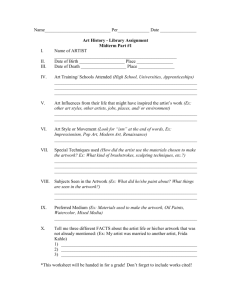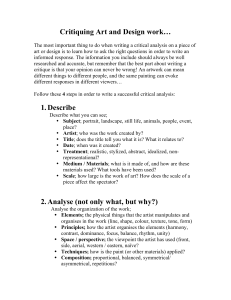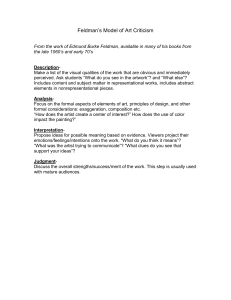Studio Arts Exam - SandringhamPhotographyYEAR12
advertisement
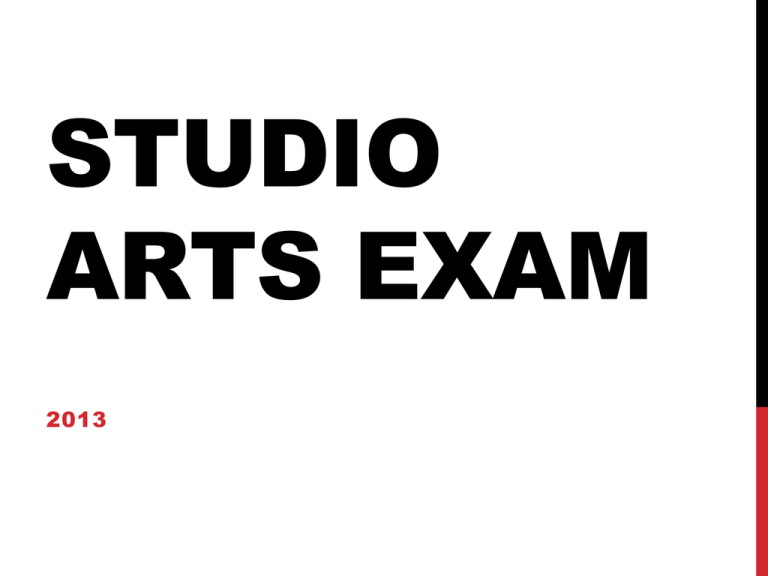
STUDIO ARTS EXAM 2013 STUDIO ARTS EXAM 2013 • Monday 11th November 2013 • 9am – 10:45 • 1 ½ hours writing time. • Worth 34 % of the total study score TIME MANAGEMENT • Duration: 1 ½ hours • Length: 3 sections • Marks: 75 • Allocation of time: just over a minute per mark STUDIO ARTS EXAM CRITERIA Criteria The following criteria will be used in context to assess the VCE Studio Arts examination paper. 1. using appropriate art language and vocabulary 2. identifying legal obligations and ethical considerations involved in the use of the work of other artists in the making of new artwork 3. describing and comparing the roles of various galleries and other art spaces 4. identifying and discussing methods and considerations involved in presenting, promoting and conserving artworks in a variety of exhibition spaces 5. analysing ways in which artists from different historical and/or cultural contexts undertake artistic practices, employ materials, techniques and processes 6. analysing ways in which artists from different historical and/or cultural contexts develop aesthetic qualities and styles in their artworks 7. understanding ways in which artworks reflect the artists’ interpretation of subject matter, influence cultural contexts and communicate ideas and meanings 8. discussing artists’ practices relating to a particular artform(s) THE EXAM • Questions can be from any area and in any form. • Examiners are looking for your ability to apply knowledge to specific questions. • Look for and respond to the instructional verb: describe, discuss, identify, compare, contrast, explain, outline… • Write neatly in a blue or black pen that the assessor won’t have trouble reading. Questions on the Studio Arts exam paper begin with a verb. This is the instructional word that tells you how to answer the question. These words are carefully chosen by the examination setters to guide you in making the correct response. Last year these words were: suggest, describe, explain, discuss, analyse and compare. Each word has a different meaning and you must learn to make the appropriate response. For example, if a question asks you to compare the roles of two exhibition spaces and you only describe each space you are not fully answering the question. To make it clear that a comparison is being made you would have to use words of phrases like ‘‘similar to’’, ‘‘different from’’, ‘‘like’’, ‘‘unlike’’, ‘‘compared with’’, or ‘‘in contrast to’’. Similarly, if a question asks you to analyse an artwork you must critically examine some aspects of this artwork in order to extract its meaning and not merely describe what you can see. Other verbs that may be used on the exam paper include: clarify, define, examine, identify, interpret, propose and summarise. It is most important that you know what these words mean and how to respond appropriately to each task. READING TIME • Read all questions a number of times. • Determine exactly what each question is asking you to do. • Look for key terms • Look for 'linked' questions • Select plates • Think about and select examples that will BEST illustrate your understanding of the question • Think about the artist question WRITING TIME • Essay question: jot down the points you will make then go back to question 1 • Answer the question, don’t write the answer you wish you could give • Use a highlighter to clarify in your mind what the question is asking – identify key terms • Keep to your time schedule • Answer all Questions SECTION A There will be 2–5 questions referring to a range of visual stimulus material which will be reproduced in the examination paper. This section will require students to apply their understanding of the key knowledge and key skills in answering questions in response to visual stimulus material. • Don't forget to nominate the number of the plate on the exam paper • Take note of conjunctions. There may be two parts to the question. Cover both parts equally. • Don’t repeat the question. Start with the artists name, “Dupain has...” The surname of the artist is sufficient • Keep to the question • Use art terminology • Take note of the artist, title, year produced, materials and size SECTION A: PAST QUESTIONS • Explain ways in which the artist has used materials and processes to make the artwork. • Discuss the ideas and meanings that are communicated in the artwork. • Discuss how aesthetic qualities contribute to the style of the artwork. • Suggest art practices and working methods the artist may have used to make the artwork. • Analyse ways in which the artist has developed aesthetic qualities and a distinctive style in the artwork. SECTION B In this section students are expected to respond in two or more paragraphs. There will be 2–5 questions on a range of written and/or visual stimulus material which will be reproduced on the examination paper. Some of the questions may provide scope for choice between varying options for response. If you are talking about galleries show that you have been there. Give examples of artists and work. Give equal attention to multiple part answers. SECTION B: PAST QUESTIONS • Describe the roles of the following art exhibition spaces; public gallery; commercial gallery; artist run space; curated on-line space • Refer to artworks 4 and 5 in the detachable insert. Discuss legal and ethical considerations that may arise from the appropriation of an artwork. (specific example given) • Give a short explanation of the following terms: art elements; historical context; aesthetic qualities; subject matter; style • There are many types of exhibition spaces. Choose two from the following list and compare their role and purpose. (list supplied) • Explain why these should be considered when making use of the work of other artists to make a new artwork: copyright law; appropriation and originality; licensing agreements; moral rights of artists • Conservation of the chosen artwork requires consideration of specific factors. Identify three factors and explain how they can be used to conserve the artwork. (specific example given) SECTION C This section requires students to answer 1–2 extended answer questions. Extended answers can include essays or writing that develops ideas in an expanded form. • The first time you write an artist’s name use their full name. • Use the surname of the artist in subsequent references. • Date works • Remember clarity and structure – write one point per paragraph Use TEEL • Respond directly to the question; watch out for irrelevance. Make strong points and show breadth. Don't go into to irrelevant discussion. • Describing what can be seen is not going to provide depth of understanding. Make a point! • Support your ideas with reference to examples • Use appropriate art language SECTION C: PAST QUESTIONS • Discuss how artworks were presented and promoted in two different exhibition spaces that you have visited this year. • Identify two different art exhibition spaces you have visited this year. Compare the roles and particular characteristics of each exhibition space. Discuss the intention of the curator or artist in displaying the artworks in each exhibition space. Discuss methods and/or considerations involved in preparing and promoting the artworks in each exhibition space. • Identify two artists from different historical and/or cultural contexts and analyse specific examples of their work in relation to all of the following. • use of materials, techniques and processes • the artist’s interpretation of subject matter and communication of ideas and meanings • aesthetic qualities and distinctive style WHAT MAKES ONE ANSWER BETTER THAN ANOTHER? • Clarity in addressing the question. Write simply and get to the point. Make sure it is relevant. • Depth which comes from detail. • Confidence comes from practice; from knowing what the answer is and giving it. Practice writing responses. • Use of art terminology. When using art terminology follow with a definition to prove that you know what it is and can articulate the way it is relevant. Elements, techniques, materials, style... • Substantiate evidence when required. Not all answers require examples but when you are asked to refer to artworks they want more than one – and they want information about the works, not the artist. DEFINITIONS STYLE Style: the distinctive or characteristic features of an art work that make it attributable to an artist or group of artists. Style, or distinctive style, is the how we differentiate one artist’s work from another’s. The way the artist interprets subject matter, uses materials and techniques is their style. Write a couple of short statements that capture the style of the artists you have studied. It is not difficult to write about the style of an artwork if you understand that the characteristics of an artwork constitute its style. Van Gogh’s paintings are characterised by strong contrasting colour, short textural brushstrokes, produced by speed of execution, that impact empathy and emotional intensity within his painting and it is these things that form his style. Van Gogh’s style is colourful and textural, evoking empathy and emotion. SUBJECT MATTER Subject matter: The images and concrete forms that you can see which are the subject of the work. The same subject matter can be used by two artists but interpreted in different ways. For example, one still life may be a literal, exact copy of ‘life’, while another may be a an abstract or even an impressionistic interpretation. After establishing the subject: Landscape, portrait, documentary …ask yourself how the artist has handled it. - Is the artwork figurative? - What is the focal point of the artwork? - What category is the subject? - What is the viewpoint? - Consider the cropping, the scale, angle of view… INTERPRETATION OF SUBJECT MATTER ‘Interpretation of subject matter’ is the phrase used to discuss the moods, emotions and feelings about the subject that the artist has create in the artwork. It is important to remember that an artist’s interpretation of subject matter will depend on many factors, including the artists values, beliefs, culture, historical factors, traditions, political interests and concerns. To interpret an artwork you need to identify and explain its parts and their significance in the composition. How has the subject been created by the artist? What visual components (e.g. symbols) have been used? When answering exam questions about unseen artworks, use speculative language in your answer as you are not necessarily expected to know all of the facts about every artist and artwork. For example, begin a sentence with ‘The artist appears to ….’ Or ‘The artist seems to ….’ To indicate that you are stating a theory or personal opinion. FORMAL ELEMENTS Art elements are the building blocks of an art work. They can be manipulated to give structure and to communicate ideas and meaning. Art elements include line, colour, texture, tone, form, shape, motion, sound and light — are basic units of the visual language of art. Principles are the combination of elements which create the aesthetic qualities; the means by which the art elements are organised into a composition. They may include such things as: emphasis, balance, harmony, proportion, rhythm, variety and unity. AESTHETIC QUALITIES Aesthetic – relates to the sensory, emotional and intellectual involvement and response to fine art. Aesthetics: the application and manipulation of Formal Elements to create a particular mood or to communicate ideas. ‘Artisan’ p169 Aesthetic qualities refer to the compositional aspects of an artwork, to the ways in which formal elements, signs and symbols can be manipulated create a beautiful or visually powerful artwork – i.e. the visual qualities of an artwork. Leading Edge – Studio Arts ‘‘Aesthetic qualities are developed by the artist using the elements and principles of art in conjunction with materials and techniques to create a desired effect. A sense of beauty, ugliness, harmony, or discord can be achieved by the artist working intuitively or intentionally with the elements and principles of art’’ (2010 Assessment Report). Aesthetic qualities are the visual qualities that influence the emotive impact attained through the use of formal elements, principles and techniques. A full appreciation of aesthetic qualities should also include a consideration of composition and an understanding of how the art elements work together. PROCESSES Processes are the steps taken to produce an art work in a particular form. An art work begins with an idea, inspiration or observation. Concept drawings, story boards, sketches are all part of the process, as is the eventual display. MATERIALS AND TECHNIQUES The medium and method to produce the art work. Identify the medium; for example charcoal on paper. Ask: What materials and techniques have been used to create the subject of the artwork? “The artist has used a forgiving traditional material which has been used to create a thick line... Go on to discuss its qualities and uses. Then go on to techniques used in this particular work. How do they relate to the subject matter? Do materials and techniques help to create emotion in the work? COMMUNICATION OF IDEAS The communication of ideas concerns the messages conveyed in the art work. Is there a story? For example, when viewing the Mona Lisa consider the cultural context. She is a rich woman. The painting shows a sensitivity to the feminine figure; there is a warm glow and the skin is soft…Determine the message. ARTISTIC INFLUENCES Artistic influences - inspiration gained from the work of another artist. Influences may be things that have affected the artist’s work, such as people, places and life experiences. Other influences include particular artists, art styles and art movements. Stylistic clues may be evident in the work. HISTORICAL AND CULTURAL CONTEXT Historical and cultural context - the impact of social traditions, beliefs and change on the vision of the artist. Think about • Dates • Events of the time • Style of the time • Change – the invention of photography affected Van Gogh and his abstraction of art. Practice Aim for 5 -6 exam papers Feedback is important Strategy to ease you r way into the exams. First exam open book no time limit Second exam open book time limit Third exam no notes and with time limit. Adjectives demonstrate depth and confidence. describe the tone or line quickly use a visual word imaging giving the answer to someone over the phone EXAMINER’S REPORT
